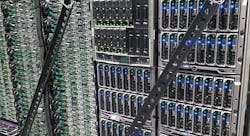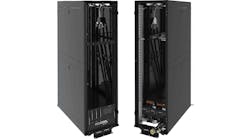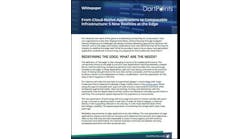Global Investors See ‘Compelling’ Opportunity in Data Infrastructure
The smart money is ready to go shopping for data centers. Some of the world’s largest investors are raising billions of dollars to invest in digital infrastructure, citing extraordinary demand for capital to fuel the data economy.
Investor interest in the sector is creating pathways to growth for data center providers, who are raising funds for global development. In July we’ve seen two examples:
- Compass Datacenters has lined up capital to deploy $3 billion of new data center capacity, with Israeli real estate firm Azrieli Group making an equity investment and existing investors RedBird Capital and the Ontario Teachers Pension Plan also adding capital.
- Equinix has formed a joint venture with GIC, Singapore’s sovereign wealth fund, that will fund six new hyperscale data centers in Europe, adding capacity in Frankfurt, London, Amsterdam and Paris.
The bottom line: Experienced investors perceive data centers as one of the best ways to make money.
“Digital infrastructure represents the most compelling investment opportunity we see today,” said Thomas Barrack, Jr., Executive Chairman and CEO of Colony Capital.
“Digital communications are evolving at an unprecedented rate,” said Marc Ganzi, CEO and Co-Founder of Digital Bridge. “As a result, demand is surging for network infrastructure across towers, small cells, fiber and data centers.”
Barrack and Ganzi have teamed to create a $4 billion warchest for their Digital Colony Partners initiative, which recently announced plans to acquire Zayo Networks. The fund initially hoped to raise $3 billion, but was increased due to strong interest from institutional investors, including sovereign wealth funds, pension funds and insurance companies.
“No one has ever raised a fund solely dedicated to this sector,” said Ganzi. “But it is clear that new capital will be needed on a global basis to support network buildout and prepare for the implementation of 5G, IoT, AI and other forms of next generation networks.”
UPDATE: Shortly after this story was published, it was announced that Colony Capital was acquiring Digital Bridge for $325 million, along with a succession plan in which Ganzi will succeed Barrack as CEO in 2021, taking the helm of a combined firm with $60 billion in assets.
Critical Assets for a Connected World
The Internet is creating a data-driven world. Virtually every business is racing to keep pace with the shift to a digital economy, which includes adoption of cloud computing, AI, the Internet of Things, robotics, autonomous vehicles and many other technologies. All these trends require infrastructure.
Data centers are central to this vision. That’s why the world’s marquee tech companies are adding data center capacity at an unprecedented rate. Building new data centers requires LOTS of capital, and after many years of wariness about the sector, the investment community has shifted gears.
“Data has been one of the fastest growing commodities in the world,” said Sam Pollock, the CEO of Brookfield Infrastructure Partners. “Our belief is that as people, places and objects become increasingly more interconnected, the importance of data infrastructure assets will rise. We expect this rapid growth to persist for the foreseeable future, driven by a number of factors including greater smartphone penetration, increasing data consumption, advent of 5G networks and other new and evolving uses such as Internet of Things, AI and other applications that depend on low latency.”
Brookfield is one of the largest infrastructure funds, which traditionally invest in capital-intensive projects like airports and toll roads, and tend to have longer timelines for returns on investment. Brookfield spent $1 billion to acquire a portfolio of data centers from AT&T to create the Evoque Data Centers colocation platform, and has also partnered with Digital Realty on the Ascenty data center platform in South America.
Infrastructure Funds With Impact
Brookfield is among a growing number of global funds pouring money into the data center sector. Other examples:
- Global infrastructure investor Alinda Capital Partners has formed a joint venture with QTS Data Centers that could provide up to $1 billion in funding for future data center construction, starting with a campus in Manassas, Virginia.
- Macquarie Infrastructure Partners (MIP) has made a strategic investment in Aligned Energy to support the company’s growth, including expansion into new markets and supply chain innovation.
- Stonepeak Infrastructure Partners acquired Cologix and is investing $500 million to help the colocation firm build bigger data centers, enter new markets, and grow through acquisition.
- IPI Data Centers formed STACK Infrastructure with assets acquired from Infomart Data Centers and T5.
- Canadian real estate firm QuadReal Property Group created a joint venture with T5 Data Centers, with plans to build or buy up to $2.5 billion in data center real estate.
- Singapore’s GIC is also the lead investor in EdgeCore Internet Real Estate, which is planning large data center campuses in five North American markets.
The data center investment landscape was the focus of recent panels at DCD Enterprise NY and the CAPRE Greater NY Data Center Summit, which highlighted two key trends. The powerful growth in data-centric business is one half of the investment case for data centers. The other factor is the changing risk profile.
“The biggest change is that investment grade companies are becoming the biggest tenants in this asset class,” said Richard Lukaj, Managing Director of Bank Street Capital.
“The risk profile of these businesses has changed,” said Chris Moon, Managing Director – Technology and Telecom Banking at ING. “It’s now long-term contracts with investment grade tenants, particularly for hyperscale. If you’re an infrastructure fund that’s run out of airports and toll roads to buy, you like the profile and upside (of data centers).”
“I think in the past three years, the capital pool and investor interest has changed dramatically,” said Jeff Ferry, a Director at Goldman Sachs Specialty Lending Group. “There’s lots of capital flowing into the sector.”
“Today we have more pockets of capital than we have ever seen,” said Joseph Junda, Managing Director of Technology, Media, and Telecommunications (TMT) at Capital One. “It’s as competitive as it’s ever been.”
Competition Comes to Data Center Financing, M&A
Panelists at DCD and CAPRE said recent financings have indeed been competitive. For data center providers, having multiple lenders and equity partners to work with is a nice change of pace. But it also alters the dynamics in lending and acquisitions.
“Any significant increase in capital into any industry with limited supply will create more competition and impact valuations,” said Rashad Kawmy, a partner at Boundary Street Capital, which provides debt financing for data center and telecom firms. “Infrastructure funds tend to have a different cost of capital target. They need to put more capital to work, and they’re able to pay a higher multiple to win that asset than others.”
The investment panel at the CAPRE Greater New York Data Center Summit featured (from left) Brian Doricko of CyrusOne, Goldman Sachs’ Jeff Ferry, Joseph Junda from Capital One, Boundary Street Capital’s Rashad Kawmy, Richard Lukaj of BankStreet, and John Regan with Landmark Dividend. (Photo: Rich Miller)
The impact of these capital inflows is clearly visible in the Montreal data center market, which is being reshaped by acquisitions by well-funded U.S. providers. In December 2018, Vantage Data Centers acquired 4Degrees Colocation, and Cologix acquired COLO-D,. Earlier this week, Compass Datacenters purchased ROOT Data Centers. All three deals are likely to bring more capital and new construction into the Montreal market.
Even with higher valuations, there are still players that are shopping.
“As opportunities come up, we take a look,” said Chris Downie, the CEO of Flexential, which is backed by private equity firm GI Partners. “We have a clear strategy, and are pretty particular about what we want. It’s thinned out a bit, but there’s always something in play.”
“There’s a lot going on in the market,” said Tim Caulfield, CEO of Evoque. “We are working with Brookfield to look at opportunities that might be a good fit, and there are several. Brookfield can do the early shopping.”
Who might be looking for merger partners or other exit opportunities? One company that is up-front about this is INAP, which recently hired Moelis & Company LLC and LionTree Advisors LLC as advisors on possible transactions.
“We believe that the INAP platform is now optimized and positioned for the next step to gain scale,” said Peter Aquino, the CEO of INAP, in the company’s recent earnings call. “We’ll explore the best opportunities to maximize value for our shareholders and we will focus the balance of 2019 to flesh out the best strategic initiatives to take INAP to the next level.
“Ultimately, we want enough footprint to handle larger customer requirements that need multiple locations,” Aquino added. “The demand for infrastructure is just on fire.”






